Labour Force
- Home
- Statistics
- Labour Market
- Labour Market Information
- Labour Force
Labour Force Survey Report, Malaysia, 2021
Key Statistics of Labour Force in Malaysia, February 2022 9 March 2022
Key Statistics of Labour Force in Malaysia, January 2022 8 February 2022
Principal Statistics of Labour Force, Malaysia, Fourth Quarter (Q4) 2021 8 February 2022
Key Statistics of Labour Force in Malaysia, December 2021 10 January 2022
Key Statistics of Labour Force in Malaysia, November 2021 8 December 2021
Key Statistics of Labour Force in Malaysia, October 2021 Show all release archives
Overview
_v14-01.png)
_v14-02.png)
INTRODUCTION
The COVID-19 pandemic continued to spread over the world in 2021, posing unprecedented hindrances to the global economy and labour market recovery. As a result, different measures to solve public health issues were developed. According to International Labour Organization (ILO), the prolonged pandemic globally has caused the working-hour losses to be continuously high in 2021, resulting in a 4.8 percent shortfall in total working hours in the first quarter, which fell marginally to 4.4 percent in the second quarter. This shortage was equivalent to 140 million full-time jobs in the first quarter and 127 million full-time jobs in the second quarter. This emphasizes the fact that the crisis is far from finished as the first half of 2021. However, the globally uneven recovery pattern was observed during the second half of 2021 as the countries resumed economic activity at varying rates and times. The jagged revitalization of economy altogether was also hurled by the headways of the vaccination programme and large-scale fiscal expenditures (ILO, 2021). In Malaysia, numerous measures have been ongoing in an attempt to achieve a compromise between protecting people's health and at the same time reviving the country's economy. Moreover, a more targeted approach was undertaken to manage the public health situation especially in the second half of 2021 as compared to a blanket restriction exercised in the preceding year.
During the first month of 2021, the labour market was in a defying situation as the number of COVID-19 daily new cases increased. As a result, most states were in the Movement Control Order (MCO) 2.0, which took effect on 13 January 2021, whereby only five essential economic sectors were allowed to operate with limited operating hours for businesses, while inter-state and inter-district travel activities have been banned. Later, this situation seems to be gradually improved in February and March 2021 as more economic and social activities are allowed to resumed coupled with the rolled-out of first vaccination programme on 24 February 2022, which providing some relief to the community.
However, the country was once again hit by a wave of COVID-19 as new daily cases became higher in May 2021, resulting in the MCO being imposed nationwide on 12 May 2021. This situation has led to the closure of educational institutions, while social and religious gathering activities are not permitted, as well as the limitation of the duration of business operations hours. During this period also, inter-state and district activities were restricted. Subsequently, since the country experience the escalating number of daily COVID-19 new cases, the implementation of full lockdown was enforced in June 2021 with the restriction of economic activities except for essential services, business operation hours as well as the traveling activities restrictions. Thus, to curb this issue, Government has implemented the National Recovery Plan (NRP) encompassing four phases and the transition of each phases is subject to the number of daily new cases, vaccination rate and the COVID-19 patient admission to the Intensive Care Units (ICU).
The battle against the pandemic endured in August and September 2021 with various initiatives and programmes executed to curtail the pandemic including the increasing number of vaccination doses given to the public. Therefore, in the middle of August 2021, more business activities were allowed to resume in Phase 1 of the NRP plus the permission for eateries to dine in except for those who are not fully-vaccinated, as well as the inter-district travel within certain areas is allowed. Additionally, Terengganu and Pulau Langkawi are open for fully-vaccinated tourists and more business activities with longer operation hours are permitted in all NRP’s phases. Therefore, it led to the encouraging labour force situation towards the end of the year.
During the last quarter of 2021, the transition phase of the NRP is showing a success, as most of the states were in Phase 4 of the NRP, which allows more economic and social activities to reopen with longer business hours. This progressive improvement has stimulated more demand for labour as businesses are operating at full capacity. Consequently, more job opportunities were created as businesses started new hiring. Moreover, full inter-state travel was allowed effective from 11 October 2021, thus fostering more traveling activity in the country and abroad, which injected some positive impact to Malaysia’s tourism industry. Therefore, the labour force remained stable in the final month of 2021 following the continuous reviving of the economy.
In terms of economic performance, after recording a slump of 5.6 per cent in 2020 due to the unprecedented event worldwide, Malaysia’s economic performance in 2021 posted an increase of 3.1 per cent. This signalling that Malaysia’s economy is in a recovery momentum. However, the 2021 performance is still below its pre-pandemic level in 2019 (4.4%). On top of various initiatives taken by the Government, the continuous resumption of economic activities with longer business hours coupled with permission for social activities and inter-state travel had significantly contributed in stimulating Malaysia’s economic performance. Thus, Malaysia’s labour force regained momentum towards recovery in 2021 reflected by a higher labour force participation rate during the year. Meanwhile, the unemployment registered an increase as country were surrounded by the pandemic for a longer period of time as compared to the previous year and this situation were also encountered in the global labour market.
LABOUR FORCE
LFPR escalated to 68.6 per cent in 2021
The number of Malaysia’s labour force in 2021 continued to register year-on-year increase, rose by 0.8 per cent (+129.4 thousand persons) to 15.8 million persons as against the previous year (2020: 15.7 million persons). The increase was due to the rising number in employment as well as the unemployed persons. Accordingly, the labour force participation rate (LFPR) in 2021 rose by 0.2 percentage points to 68.6 per cent (2020: 68.4%). [Exhibit 1]
Exhibit 1: Principal Statistics of labour force, Malaysia, 2020 and 2021
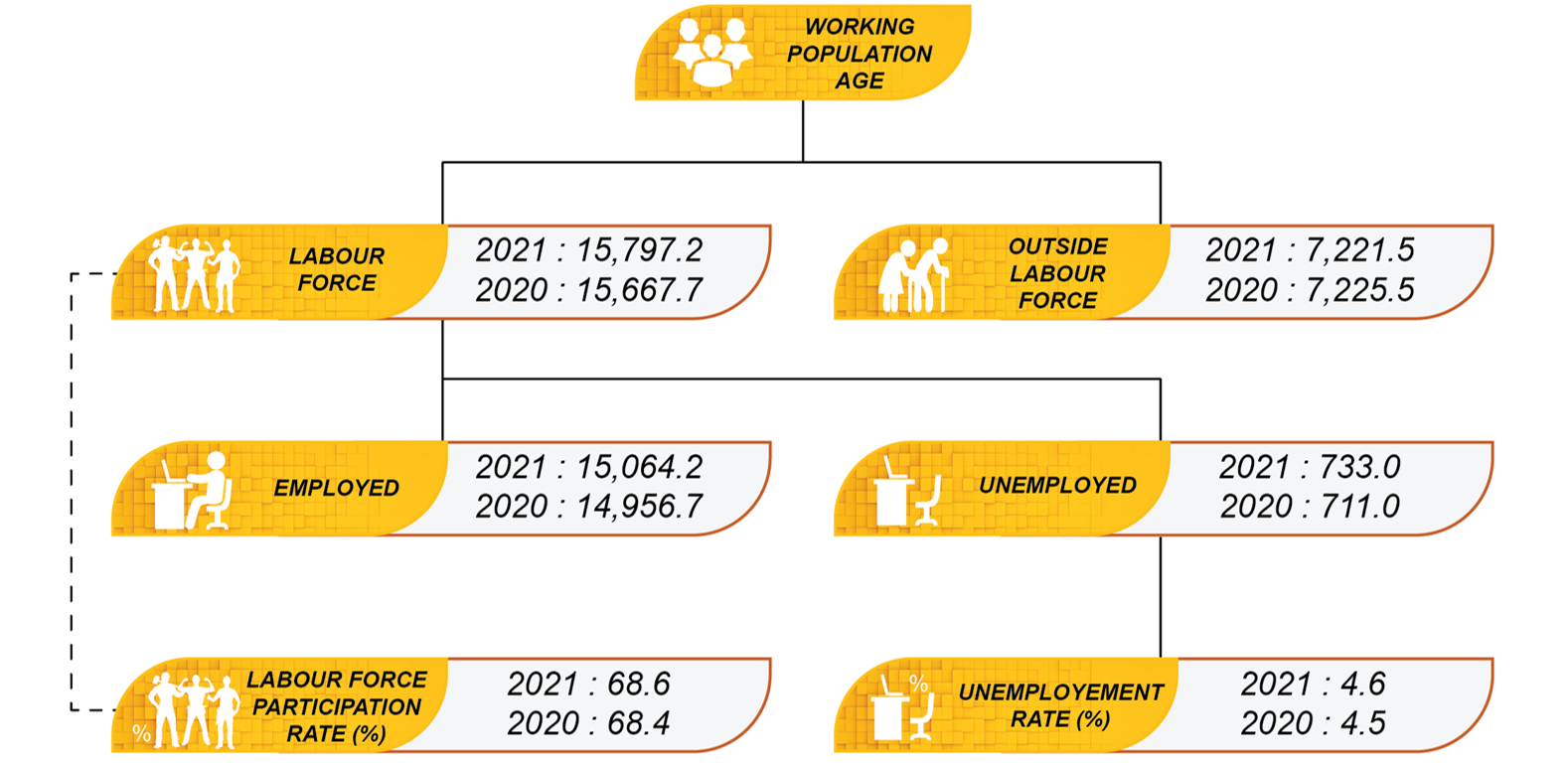
Age group 25 to 29 years was the largest group of labour force encompassed 17.7 per cent (2.8 million persons). Age group 30 to 34 years was second with a share of 14.8 per cent or equivalent to 2.3 million persons and followed by age group 35 to 39 years, recording 13.7 per cent (2.2 million persons). [Chart 1]
Chart 1: Labour force by age group, Malaysia, 2020 and 2021
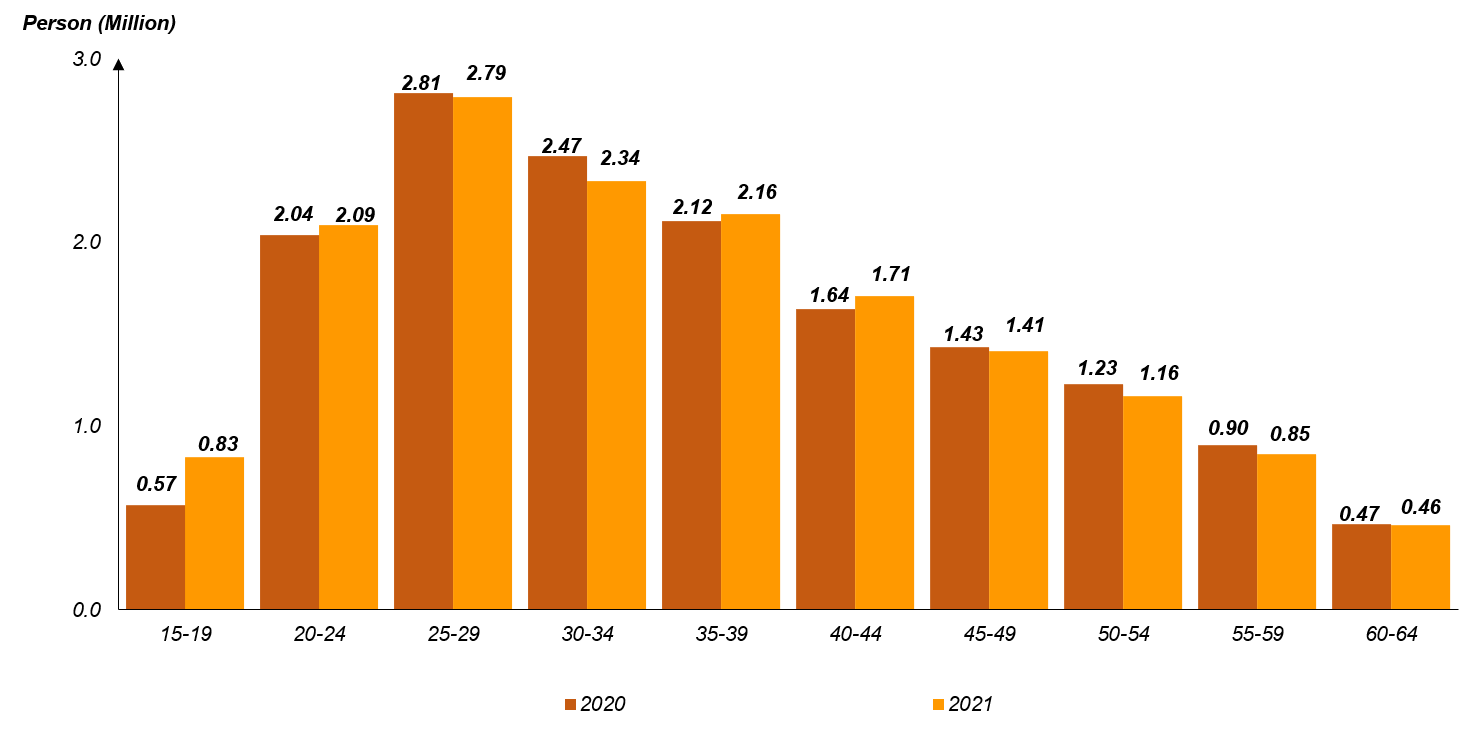
EMPLOYED PERSON
Employed person increased by 0.7 per cent to record 15.06 million persons
Employed person recorded a total of 15.06 million persons in 2021, rose by 0.7 per cent or equivalent to 107.4 thousand persons as compared to the previous year (2020: 15.0 million persons). Subsequently, the ability of an economy to create employment indicated by the employment-to-population ratio, improved 0.1 percentage point year-on-year registering 65.4 per cent (2020: 65.3%).
Looking at the status in employment, employee’s category which made up the largest composition of employed persons with 78.5 per cent, posted a year-on-year increase of 2.3 per cent to 11.8 million persons (2020: 11.6 million persons). Meanwhile, the own-account workers accounted for 14.8 per cent, dropped by 6.4 per cent to 2.2 million persons in 2021 (2020: 2.4 million persons). [Chart 2]
Chart 2: Employed persons by status of employment, Malaysia, 2020 and 2021
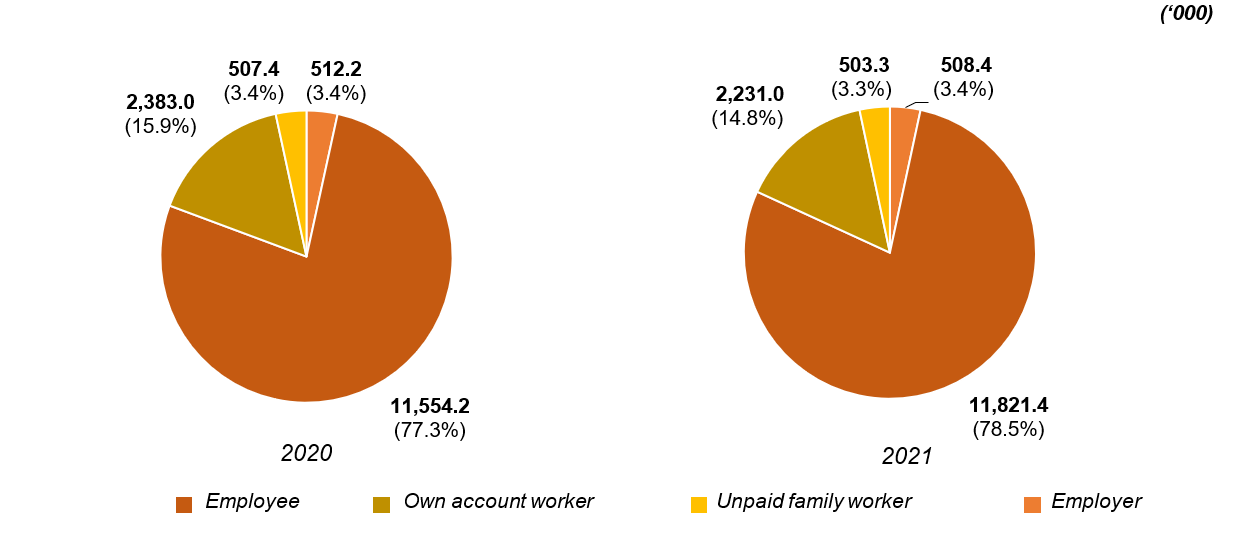
Working less than 30 hours per week, time related underemployment and skill-related underemployment
Employed person working less than 30 hours per week refers to those who worked less than 30 hours during the reference week because of the nature of their work or due to insufficient work. Towards the end of 2021, almost all states were shifted to Phase 4 of the NRP which allowing businesses to operate with longer business hours. Therefore, the number of employed persons working less than 30 hours per week decreased by 25.0 per cent year-on-year (-139.4 thousand persons) to register 417.4 thousand persons (2020: 556.8 thousand persons). Those employed for less than 30 hours per week accounted for 2.8 per cent of total employed persons, dropped by 0.9 percentage points in 2021 (2020: 3.7%). [Chart 3]
Chart 3: Employed persons working less than 30 hours per week, Malaysia, 2015 - 2021
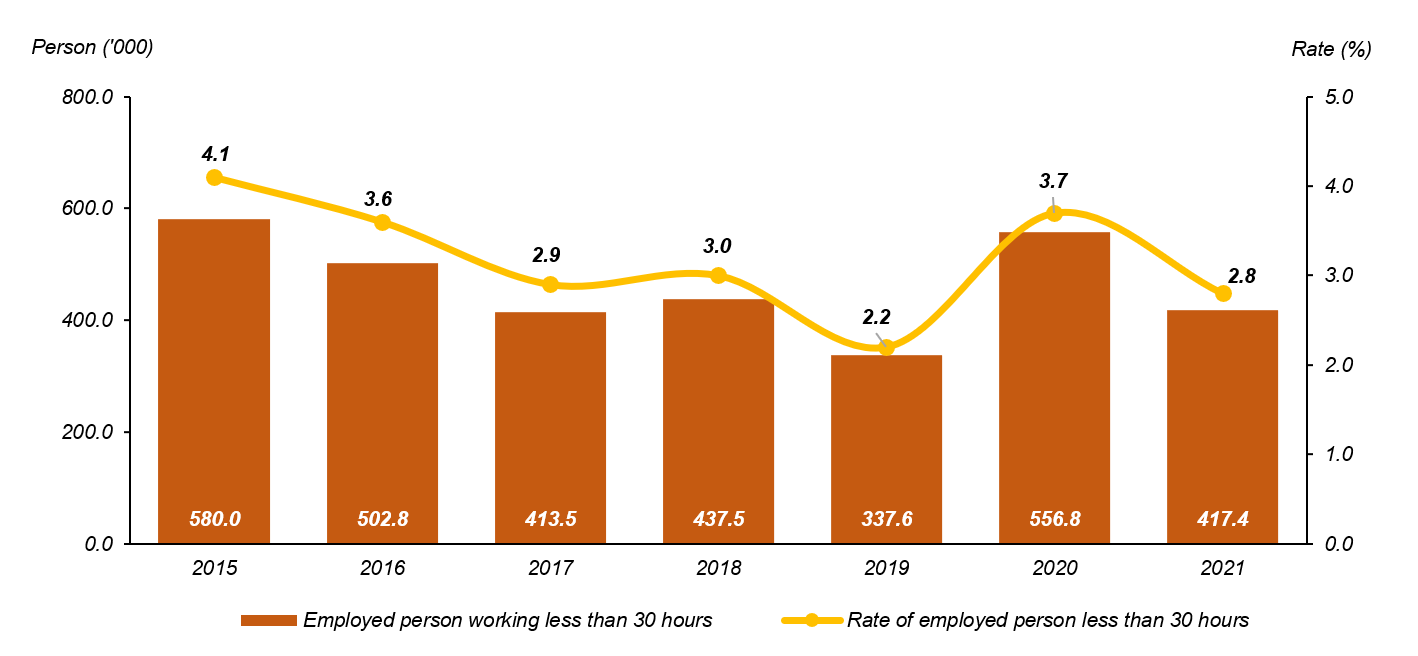
Subsequently, the rate of time-related underemployment in 2021 dropped by 0.3 percentage points to 1.9 per cent (2020: 2.2%), registering a reduction of 14.4 per cent (-48.2 thousand persons) to 285.8 thousand persons of time-related underemployment. Time-related underemployment is defined as those who were employed less than 30 hours per week due to the nature of their work or because of insufficient work; and were able and willing to work additional hours of work [Chart 4]
Chart 4: Time related underemployment, Malaysia, 2015 - 2021
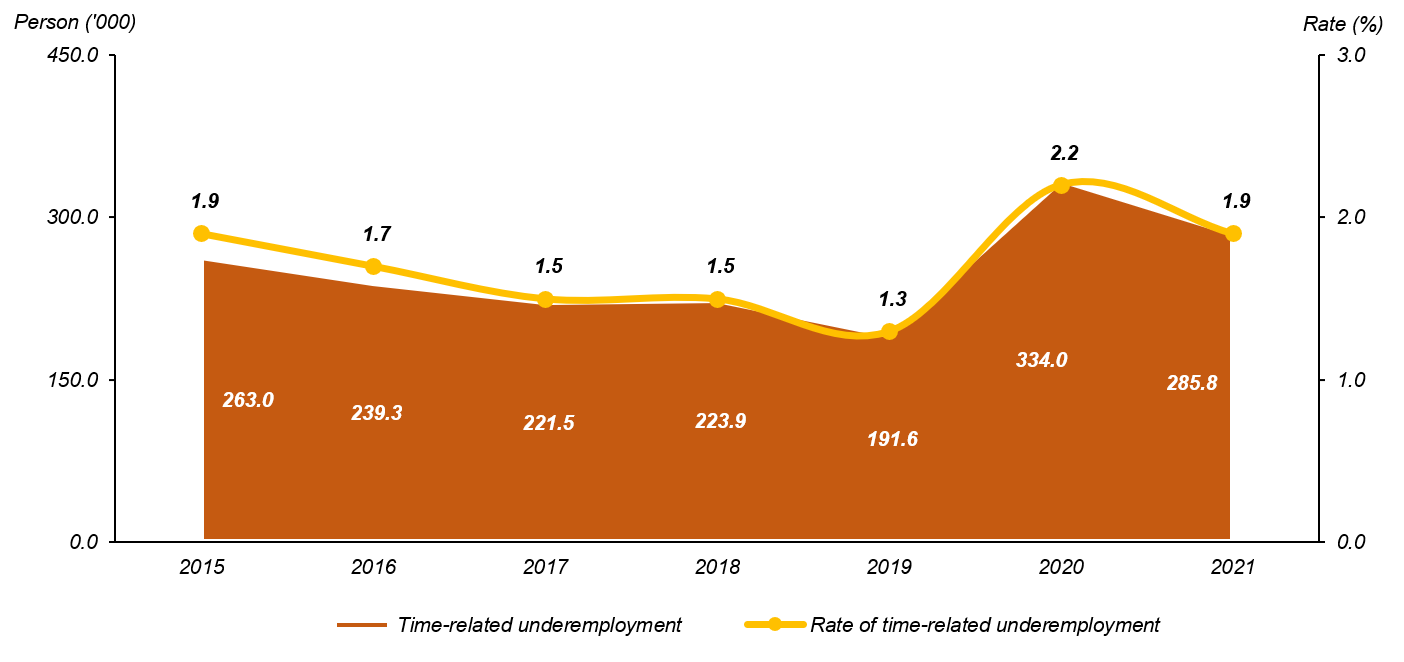
Generally, job mismatch refers to a situation where a person had to accept a job that requires skills lower than his educational achievement. Therefore, it can be portrayed through the indicator of skill-related underemployment which measures those with tertiary education and working in the category of semi-skilled and low-skilled jobs. In 2021, skill-related underemployment increased by 6.3 per cent (+114.6 thousand persons) to record 1.9 million persons (2020: 1.8 million persons). Hence, the rate of skill-related underemployment to employed persons with tertiary education edged up from 38.0 per cent in 2020 to 38.7 per cent in 2021. [Chart 5]
Chart 5: Skilled-related underemployment, Malaysia, 2015 - 2021
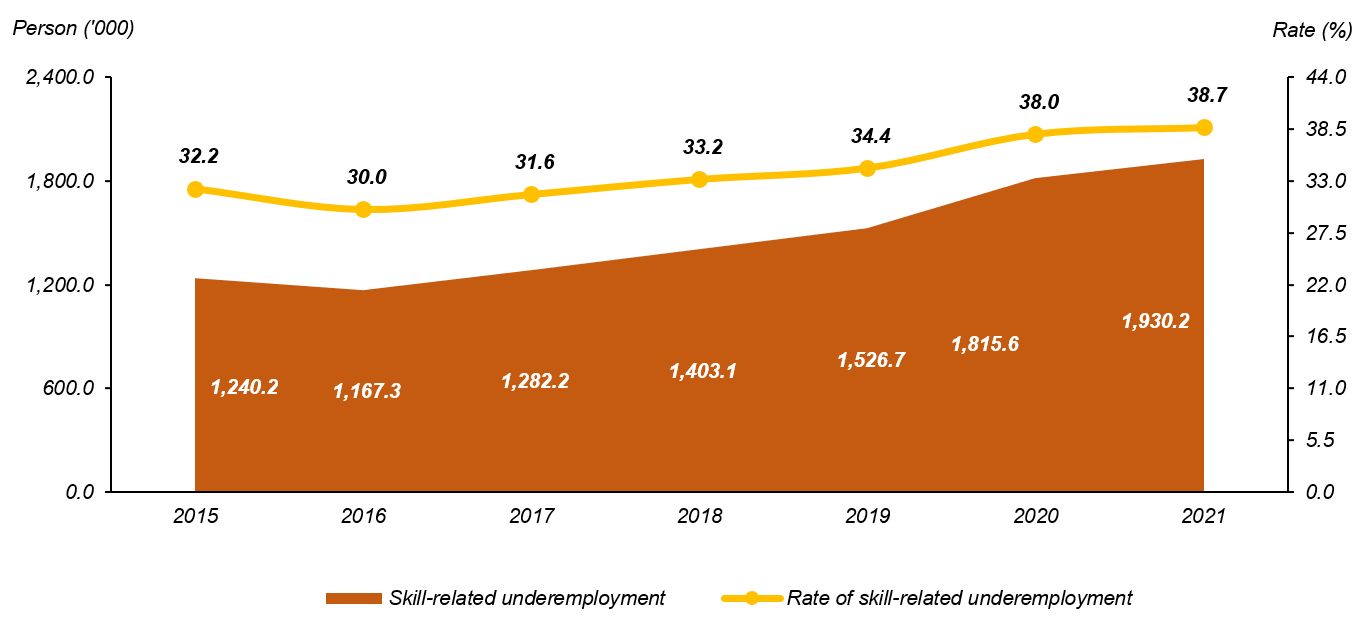
As more social and business activities were allowed to operate with extended business hours including permission of inter-state traveling and selected destination tourism activities to reopened, the number of employed persons who were temporarily not working recorded a decline of 66.1 per cent or 581.5 thousand persons to 298.2 thousand persons in 2021 (2020: 879.6 thousand persons).
UNEMPLOYMENT
Unemployment rate in 2021 increased slightly to 4.6 per cent
As compared to the previous year, the unemployment rate in 2021 increased slightly by 0.1 percentage point to record 4.6 per cent as the battle against the pandemic continued during the year. Year-on-year basis, the number of unemployed persons went up by 3.1 per cent or equivalent to 22.0 thousand recording 733.0 thousand unemployed persons (2020: 711.0 thousand persons).
As for the youth unemployment rate, the unemployment rate for youth aged 15 to 24 years reduced by 0.7 percentage points to record 11.3 per cent (2020: 12.0%), recording 329.1 thousand unemployed youths in 2021. Likewise, the unemployment rate of youth aged 15 to 30 years dropped to 8.1 per cent (2020: 8.3%). The unemployment rate for adult aged 25 to 64 years rose by 0.1 percentage point to 3.1 per cent (2020: 3.0%). [Chart 6]
Chart 6: Unemployment rate by selected age groups, Malaysia, 1982 - 2021
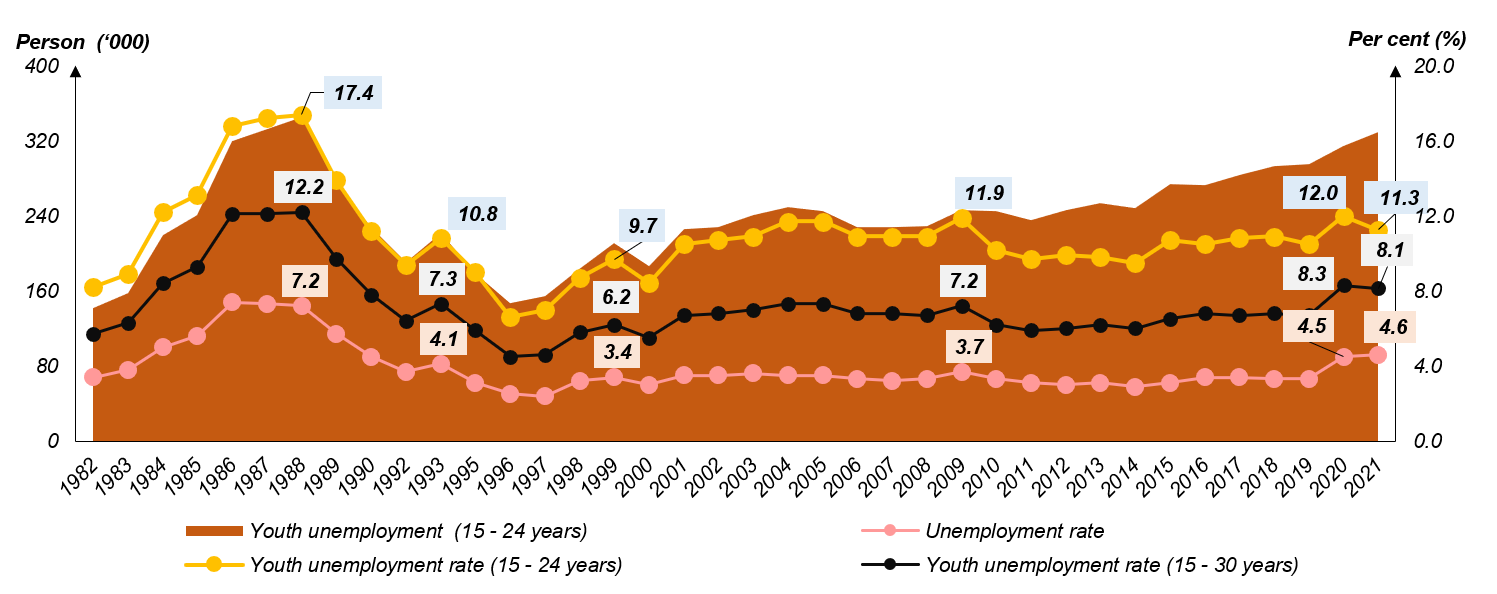
OUTSIDE LABOUR FORCE
Main reason of outside labour force was due to housework/ family responsibilities
In 2021, the main reason of outside labour force was due to housework/ family responsibilities. This group accounted for 45.2 per cent from the total of outside labour force and followed by schooling/ training with a percentage share of 41.1 per cent. [Chart 7]
Chart 7: Share of outside labour force by reasons for not seeking work, Malaysia, 2019 and 2020
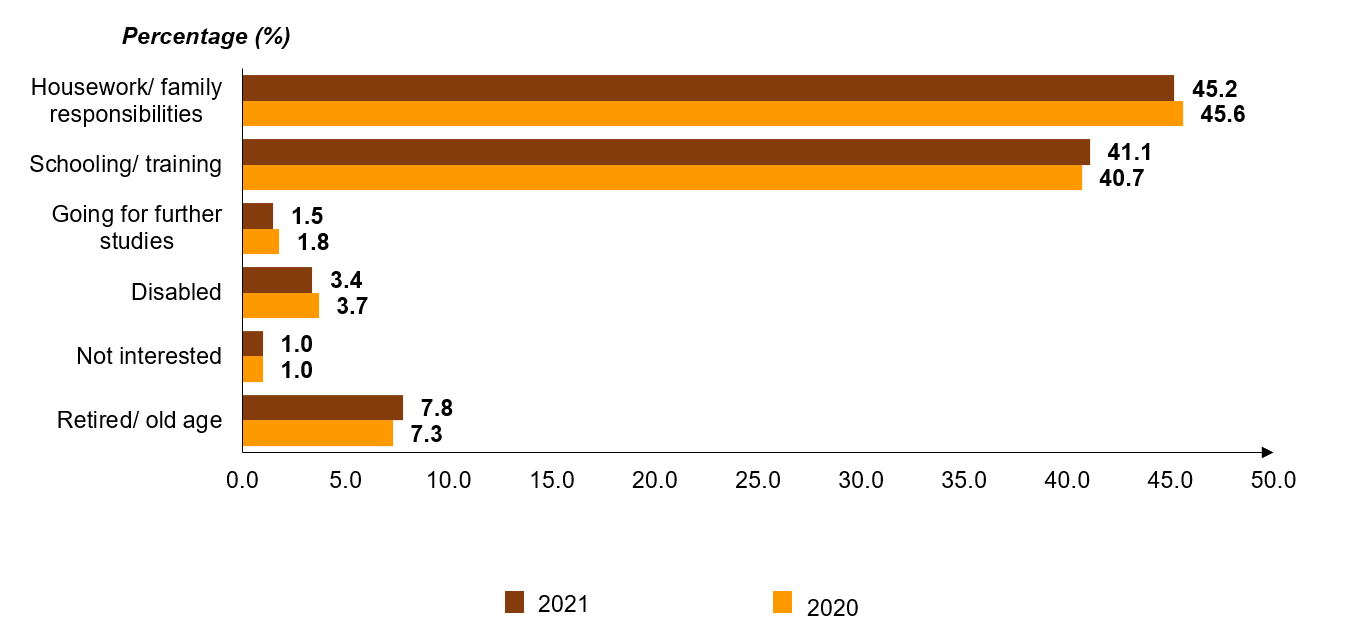
CONCLUSION
The battle against the pandemic prolonged into year 2021, therefore the economic as well as the labour market recovery process to some extent was hindered due to the impact of the pandemic. Consequently, the Malaysian labour market remains in a challenging situation due to uncertainties. Apart from that, the implementation of "full lockdown" nationwide in June 2021 gave some hurdles to the labour market in regaining its momentum, as this strict measure only allowed essential services to operate while travel restrictions were tightened.
Thus, to ensure that public health is protected and enables the country's economy to reopen in stages, various initiatives were implemented through the NRP including the National COVID-19 Immunisation Programme with an increasing vaccination rate in the community. Towards the end of 2021, as most of the states were in Phase 4 of the NRP, the continuous resumption of economic activities with longer business hours coupled with permission for social activities and inter-state travel had contributed significantly in stimulating Malaysia’s economic performance. Thus, Malaysia’s labour force regained momentum towards recovery in 2021.
Looking ahead on the situation in 2022, the national labour market had been on the road to recovery with continuous improvement since January 2022. This could be attributed to ease of socioeconomic restrictions following the shift of the whole country to the Phase 4 of the NRP. The transition to endemic phase effective from 1 April 2022 has opened up more opportunities since businesses are allowed to operate at pre-pandemic hours while international borders are reopened once again. The news which coincides with the fasting month of Ramadan and the subsequent Eid festival is anticipated to influence demand for goods and services. These positive developments may contribute towards hiring of more employees, creation of new jobs and consequently provide the impetus for economic growth. Therefore, Malaysia’s labour market is foreseen to speed up the recovery momentum in the near future as economy continue to improve.
The full publication of the Labour Force Survey Report, Malaysia, 2021 can be downloaded through eStatistik Portal.
For more details, please refer to the Department’s portal: www.dosm.gov.my
Released By:
DEPARTMENT OF STATISTICS, MALAYSIA
27 APRIL 2022
Contact person:
Mohd Yusrizal bin Ab. Razak
Public Relation Officer
Strategic Communication and International Division
Department of Statistics, Malaysia
Tel : +603-8885 7942
Fax : +603-8888 9248
Email : yusrizal.razak@dosm.gov.my
Subscribe
Newsletter
Subscribe to our newsletter and stay updated
For interviews, press statement and clarification to the media, contact:
Baharudin Mohamad
Public Relation Officer
Email: baharudin[at]dosm.gov.my
Phone: 03 8885 7942
Not found what you looking for? Request data from us, through
Go to eStatistik
email to data[at]dosm.gov.my
call 03 8885 7128 (data request)









